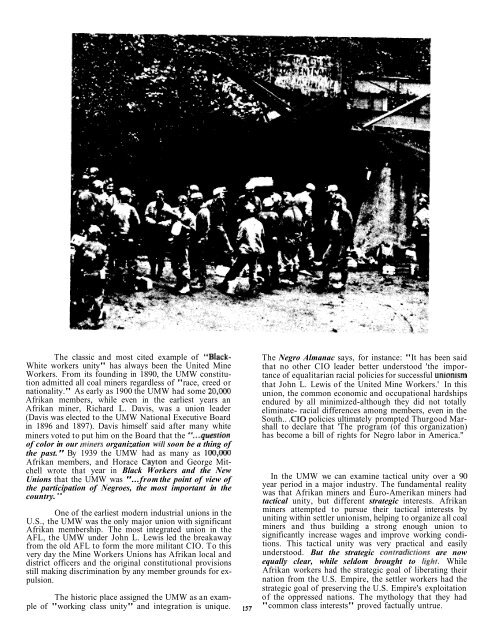sakaisettlersocr
sakaisettlersocr
sakaisettlersocr
Create successful ePaper yourself
Turn your PDF publications into a flip-book with our unique Google optimized e-Paper software.
The classic and most cited example of "Black-<br />
White workers unity" has always been the United Mine<br />
Workers. From its founding in 1890, the UMW constitution<br />
admitted all coal miners regardless of "race, creed or<br />
nationality." As early as 1900 the UMW had some 20,000<br />
Afrikan members, while even in the earliest years an<br />
Afrikan miner, Richard L. Davis, was a union leader<br />
(Davis was elected to the UMW National Executive Board<br />
in 1896 and 1897). Davis himself said after many white<br />
miners voted to put him on the Board that the "...question<br />
of color in our miners organization will soon be a thing of<br />
the past." By 1939 the UMW had as many as 100,000<br />
Afrikan members, and Horace Cayton and George Mitchell<br />
wrote that year in Black Workers and the New<br />
Unions that the UMW was "...from the point of view of<br />
the participation of Negroes, the most important in the<br />
country. "<br />
One of the earliest modern industrial unions in the<br />
U.S., the UMW was the only major union with significant<br />
Afrikan membership. The most integrated union in the<br />
AFL, the UMW under John L. Lewis led the breakaway<br />
from the old AFL to form the more militant CIO. To this<br />
very day the Mine Workers Unions has Afrikan local and<br />
district officers and the original constitutional provisions<br />
still making discrimination by any member grounds for expulsion.<br />
The historic place assigned the UMW as an example<br />
of "working class unity" and integration is unique.<br />
The Negro Almanac says, for instance: "It has been said<br />
that no other CIO leader better understood 'the importance<br />
of equalitarian racial policies for successful unionlsm<br />
that John L. Lewis of the United Mine Workers.' In this<br />
union, the common economic and occupational hardships<br />
endured by all minimized-although they did not totally<br />
eliminate- racial differences among members, even in the<br />
South.. .CIO policies ultimately prompted Thurgood Marshall<br />
to declare that 'The program (of this organization)<br />
has become a bill of rights for Negro labor in America.''<br />
In the UMW we can examine tactical unity over a 90<br />
year period in a major industry. The fundamental reality<br />
was that Afrikan miners and Euro-Amerikan miners had<br />
tactical unity, but different strategic interests. Afrikan<br />
miners attempted to pursue their tactical interests by<br />
uniting within settler unionism, helping to organize all coal<br />
miners and thus building a strong enough union to<br />
significantly increase wages and improve working conditions.<br />
This tactical unity was very practical and easily<br />
understood. But the strategic contradicfions are now<br />
equally clear, while seldom brought to light. While<br />
Afrikan workers had the strategic goal of liberating their<br />
nation from the U.S. Empire, the settler workers had the<br />
strategic goal of preserving the U.S. Empire's exploitation<br />
of the oppressed nations. The mythology that they had<br />
"common class interests" proved factually untrue.


